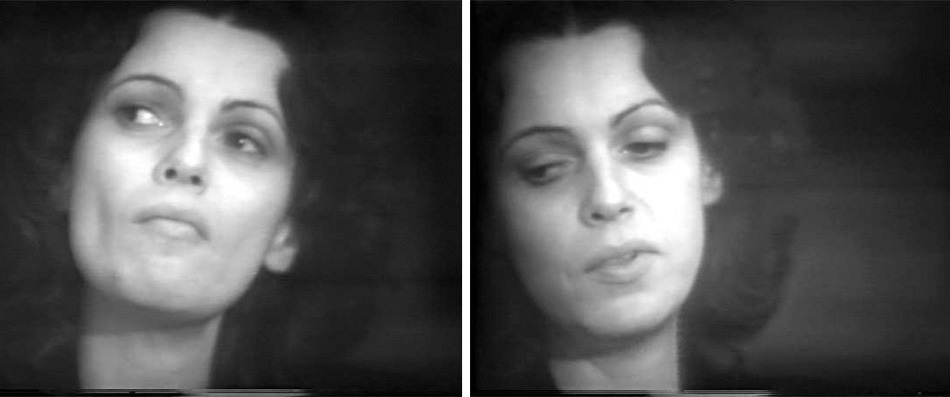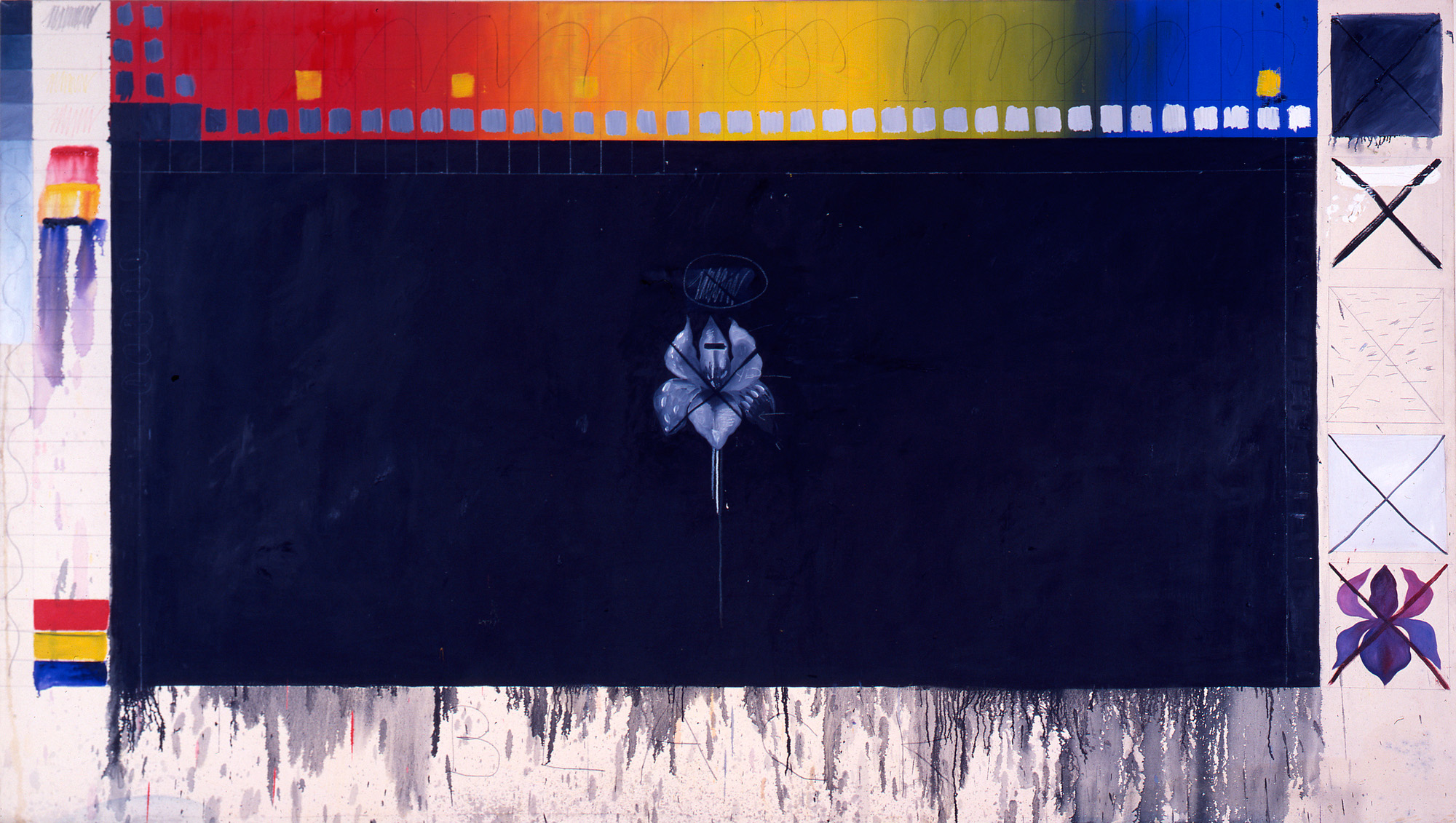Pat Steir on CalArts
by Judith Olch Richards
This transcript has been edited from a longer interview with Pat Steir, conducted by Judith Olch Richards in New York City, March 1–2, 2008. Archives of American Art, Smithsonian Institution.

Stills from Lyn Blumenthal and Kate Horsfield, Pat Steir 1975: An Interview. Copyright of the artists. Courtesy Video Data Bank.
In this brief extract from a long discussion of a painting career spanning several decades, Pat Steir describes her first visit to Los Angeles and the four years she subsequently stayed there on and off, both painting and teaching at CalArts.
PAT STEIR: I got a job in the early ‘70s at CalArts and I taught there for one whole year, and then for half a year for the next few years, until ‘75.
JUDITH OLCH RICHARDS: And what was that like, being in a completely different art world?
PS: Well, I’m very bad—it wasn’t so different. Well, this is what happened. I was at a dinner with Marcia Tucker and Bruce Nauman, and Bruce, at 30, was having his retrospective at the Pasadena museum [actually at LACMA]. He said, “Why don’t you come?” So I thought, Why not? Now, when I met Marcia, Marcia introduced me to the art world, to all those women, Elizabeth Murray. Mary Heilmann I met on my own, and Joan Snyder I met on my own. But the others she introduced me to, including John Baldessari, to all the people that I know still.
So when I went out there, John asked me if I would do a lecture at CalArts. I had been—my work had been well‑known for about, I don’t know, six months, a year. John put signs up all over the school saying, “Somewhat famous artist is here.” You know, “Pat Steir is here to do a guest lecture.” And I did the lecture. Paul Brach was there, and he asked me if I had a job, if I wanted a job. Well—
JOR: He was the head of the department?
PS: Yeah. He was the head of the department. And he was a genius head of a department. And so I said sure. Well, I had been staying with Bruce and his then-wife, Judy, and they—
JOR: So he was teaching there, too?
PS: No, no, I just met him through Marcia because, if you remember, Marcia did a show of his work, when he was a baby.
JOR: And he was living in Southern California?
PS: Pasadena.
JOR: But CalArts, was it in Valencia then?
PS: Valencia. It was a drive. So I said, “Till I find an apartment, can I stay in your house?” He said yes. He said, “There’ll be another guest. Will you feed the parrot next door?” And I said yes. And he went away and, very trustingly, left me this beautiful fancy car that I could drive. I don’t know how long he was gone. One day he called up very angry. “Pat, the neighbor tells me you’re living with a man there.” I said, “It’s your other guest.” That was Sol LeWitt, and we stayed together for years after that. [laughs] We stayed together for years and stayed friends forever. And I’m close to his family. His wife is a good friend.
JOR: Uh‑huh. So how long were you living in Bruce Nauman’s house in Pasadena?
PS: Not so long. I got an apartment.
JOR: Six months or—
PS: Yeah, maybe six months, three months. And then I got an apartment.
JOR: Closer to school?
PS: Closer to school, which was awful. Every day I was going someplace in the car. I met artists there, in Venice—you know, Chuck Arnoldi, Ed Ruscha, all the California artists.
JOR: Was the atmosphere for women artists better? Worse?
PS: Much worse. I mean, those guys are really— But they’re nice to me now.
JOR: But then?
PS: They weren’t not nice to me but—
JOR: But when Paul Brach invited you to teach, do you think it’s because he was consciously wanting to add a strong woman to the faculty?
PS: They had that already—Miriam Schapiro was his wife. And they were beginning to have this Feminist Art Department. No, Paul didn’t want strong women or not. He thought I would be a good teacher.
JOR: Oh.
PS: That’s all. And then they started the Feminist Art Department. I didn’t teach in it. Well, I had a big fight with Lucy Lippard, though we stayed friends, an argument, an ongoing discussion, about the feminist—teaching feminist art to a group of women. I was very against it. I thought it was ghettoizing, anti‑inclusion.
JOR: I actually haven’t heard about a feminist art department. Does it exist in a lot of other places?
PS: Just at CalArts. Mimi Schapiro and Judy Chicago—I’m sure you have, but you don’t remember. Or I’m not calling it the right name. They had a department headed by Miriam Schapiro and Judy Chicago teaching art to women. Oh, no, it was very famous. You’ve heard of it.
JOR: Okay.
PS: I’m just not calling it the right thing. You know, they did The Dollhouse and had—
JOR: Yes. Sure.
PS: That’s from there. I didn’t teach in that. I didn’t agree with it. I taught in a different way. I taught drawing classes and painting classes, and my star students, and still good friends, were David Salle and Ross Bleckner. Ross drove me everywhere until I could get a driver’s license. I’m a terrible driver. I had to take driving lessons again to get a license. I think I tried three times, and three was the last you could do. And finally I got a license, and he didn’t have to drive me anymore. They were graduate students, so I wasn’t that much older than they were. And, in fact, my work gets thrown in with their—
JOR: Was Sol LeWitt teaching there, too? What was he doing there?
PS: No. He was busy becoming famous. He was there because he was— I guess he was going to have a show at the Pasadena Art Museum. That’s why he was there, and, you know, his shows are long. He came to talk to them and then stayed. Maybe. Then he went back to New York, and I started to teach half a year. Then Lynda Benglis taught half a year, and I taught half a year. Lynda had a fabulous apartment, and I used it the half a year she wasn’t. When I have a show in New York—she shows at the same gallery now, and they have a hallway you can see into—I ask, “Why don’t you hang a Lynda there?” Because when I painted the roses there in California, the crossed‑out roses, Lynda always left some sculpture hanging and one couldn’t move it. You just had to cover it not to put paint on it. And so I got used to seeing—especially the roses with those knots. She had started to do the knots. They looked good together. So I got to know Lynda actually in California.
JOR: So when you—you taught for, you said, a year and a half?
PS: Oh, no. I taught at—I taught for about four years.
JOR: Oh.
PS: But for the first year, for a whole year, and then for the other—or for the first two years a whole year, and then for the other years a half a year.
JOR: How did being there affect or influence your work?
PS: I started to make black paintings.

Pat Steir, Black, 1973. Oil and pencil on canvas, 72 x 132 in. Collection of Steven D. Robinson. Courtesy of the artist.
JOR: It was that bad?
PS: Because it was so bright. And the school gave me a studio. I asked for a studio with a big window and huge view, and then I had to keep the shades closed all the time because it was too bright to see colors. You couldn‘t see colors in so much light. I started to do those black paintings with color scales and rainbows in them.
JOR: Mm-hmm. Yes.
PS: And the roses crossed out I painted there, after the Four Quartets with T.S. Eliot. They all have lines from those poems as their titles.
JOR: Right.
PS: But the one unusual painting I painted there was Line Lima as in lima bean, and that’s the one that the Whitney showed in the big show.
JOR: When you were there and you had a studio at the school, did the painters talk to each other? Did you feel that that was a supportive environment?
PS: Oh, yeah. It was wonderful. There weren’t many painters. But there was John Baldessari, and around in the neighborhood was Michael Asher. And I was friends with Eric Orr and Ron Cooper and Larry Bell and all those guys, you know. The studio that I shared with Lynda was like in the center of guyland.
JOR: So do you think it had a positive impact on your work, being there? Or if not positive, it would—your work reflected that experience?
PS: I’m not sure. I don’t know.
JOR: Or it might have been the same if you were painting in New York at that moment in your mind?
PS: I can’t say that, either, because everything affects everyone. Let’s say I can’t pinpoint how it affected the work. I’m positive it did, and I’ll you why, because I always said, you know, “Red is red; blue is blue. I use red and blue and black and white and yellow, and how can anything affect that?” But I spent one summer in Rome, using a friend’s very small studio. I painted very small paintings, and I put them in my bag when it was time to come home. When I opened the bag and looked at the paintings, Rome jumped out. Roman colors jumped out. So of course California affected the work, but I can’t say how.
This is an edited version of a much longer oral history. To read the entire transcript click here.